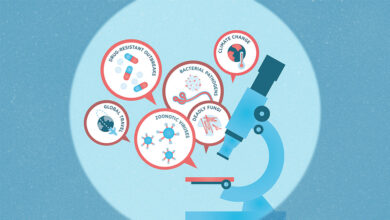
Impacts of Artificial Intelligence on Connected and Autonomous Vehicles and Precision Medicine
Recommendations: Precision Medicine
The following 12 recommendations—drawn from discussions during the symposium—are grouped under the four themes covered during the day. The recommendations reflect the views raised by participants and the essence of their interactions and conversations. The four themes of discussion were complementary and should not be viewed in isolation. The issues raised touch on multiple dimensions, from the need for a vision to the establishment of a national data approach and the implementation of modern regulations to spur innovation in precision medicine, all of which are interconnected.
Towards a Pan-Canadian Approach to AI Applications in Precision Medicine – Form Follows Function
1. Establish a new national entity responsible for the oversight of health data that may be modelled on international best practices with the purpose of leveraging AI in precision medicine. This could entail a data trust to provide a framework of agreements between government and industry and the development of options for creating a decentralized yet accessible and compatible data platform.
2. Initiate the creation of digital platforms that will facilitate the development of pharmaceuticals and the uptake of new technologies that leverage AI and precision medicine. This entails leveraging existing coalitions’ networks and public entities that have health data repositories to interconnect the current siloed databases and transition towards a pan-Canadian platform of health data.
3. Develop a strategy to coordinate efforts in precision medicine, to ensure that all actors contribute to the adoption of AI applications and innovative medical devices, highlighting the health innovation ecosystem and the needs of healthcare centres.
Technology Enablers – Fast Pace Innovation
1. Empower an environment for experimentation with the right incentives to accelerate the development, commercialization, and uptake of new technologies in Canada’s healthcare system (e.g., regulatory sandboxes).
2. Set priorities in the pursuit of R&D and innovation, addressing barriers and gaps in the development, demonstration and commercialization of technologies within the Canadian healthcare system.
3. Accelerate the application of digital platforms in the development of new drugs, therapeutic areas, and patient care leveraging data analytics, bio-informatics and AI in the field of precision medicine and personalized care.
Therapeutic Areas for Health AI and Analytics – New Frontiers of Care
1. Identify priority therapeutics areas that would benefit the most from the application of digital technologies, AI, and analytics, leveraging the largest data depositories across Canada. This includes the use of AI to scour existing clinical trial data and the creation of new virtual models for the treatment of specific diseases.
2. Create effective partnerships among relevant departments, namely ISED and Health Canada, industry and provinces to advance precision medicine and to set ambitious national goals such as the National Cancer Moonshot Initiative in the US.
Standards and Regulations – Enabling Creativity
1. Design an enabling regulatory framework that serves progress with clear standards and regulations around AI and data issues, ensuring accessibility, security, privacy, and the interoperability of high-quality data.
2. Address issues of data ownership and security while being inclusive in discussing the importance of access to personal data and its use for research and treatment. This includes implementing international best practices and using case studies to explore practical options for attaining meaningful patient consent in an AI-enabled world.
3. Bring together the top 50 thinkers and decision-makers in the field of digital health to discuss best practices and inform policymaking in adapting a regulatory framework to the needs of a rapidly changing environment.
4. Establish a regulatory framework for a pan-Canadian patient data platform where an invitation to participate is automatic, simple, and effective.
Recommendations: Connected and Automated Vehicles
The following are 12 key recommendations drawn from the discussions that took place during the symposium, with the aim of advancing Canada’s leadership in the AI and CV/AV domain:
Canada’s AI Economic Ecosystem
1. Work with stakeholders from industry, academia and all orders of government to develop a national CV/AV strategy that includes addressing challenges related to AI applications and that coordinates all efforts to position Canada as a global leader in this space;
2. Update and create flexible, self-improving regulations to close the gap between the pace of technological advances in both AI and CV/AVs and the pace of regulatory response, all while maintaining a regulatory regime that encourages innovation — including updating Canada’s transportation, infrastructure, telecommunication, IP, privacy and cybersecurity laws and regulations;
3. Cooperate with the United States to ensure interoperability of AI and CV/AV innovations, as well as safety, data, cybersecurity and infrastructure standards in both countries.
4. Create a single-window concierge service for the coordination of incentive programs at the federal, provincial and municipal levels, to reduce the added administrative burden to Canadian businesses;
Brain Gain vs. Brain Drain
1. Convene a network of Canadian global management talent with a proven track record in scaling-up and managing MNEs to mentor, provide advice and opportunities for Canadian tech companies, including those in the CV/AV space;
2. As part of a broader skills strategy, commit to identifying, developing, attracting and retaining the talent and skills needed to advance AI and CV/AVs in Canada;
AI for Social Good
1. Build a national data framework to ensure due diligence in the collection, use, access, protection, cooperation and interoperability of big data—including the development of shared public datasets and environments for AI training and testing with respect to CV/AVs;
2. Develop a Canadian code of ethics for AI that establishes standards and best practices in the development and use of intelligent machines and vehicles;
Leadership Areas for Automotive AI
1. Invest in digital infrastructure and rethink the relationship between digital and traditional infrastructure to create an environment where AI innovation can thrive — including integrating digital infrastructure assessments in all future infrastructure spending and planning decisions related to CV/AV and more broadly;
2. Continue to work with businesses to showcase and promote Canadian talent, AI capabilities and our automotive cluster to attract inward investment and establish Canada as a global leader in the development and implementation of AI and CV/AVs, and work with Canada’s trade commissioners in key markets to identify export opportunities and investment leads.
3. Grow the Government’s role as an early investor and first customer for Canadian start-up innovations and technology by investing in and expanding programs that bridge the pre-commercialization gap, such as the Build in Canada Innovation Program (BCIP) which aims to procure and test late-stage innovative goods and services within the federal government before taking them to market.
4. Continue to invest in research and development for automated and connected vehicles, including ensuring a wide range of testing facilities and environments to validate the development and implementation of emerging technologies.








